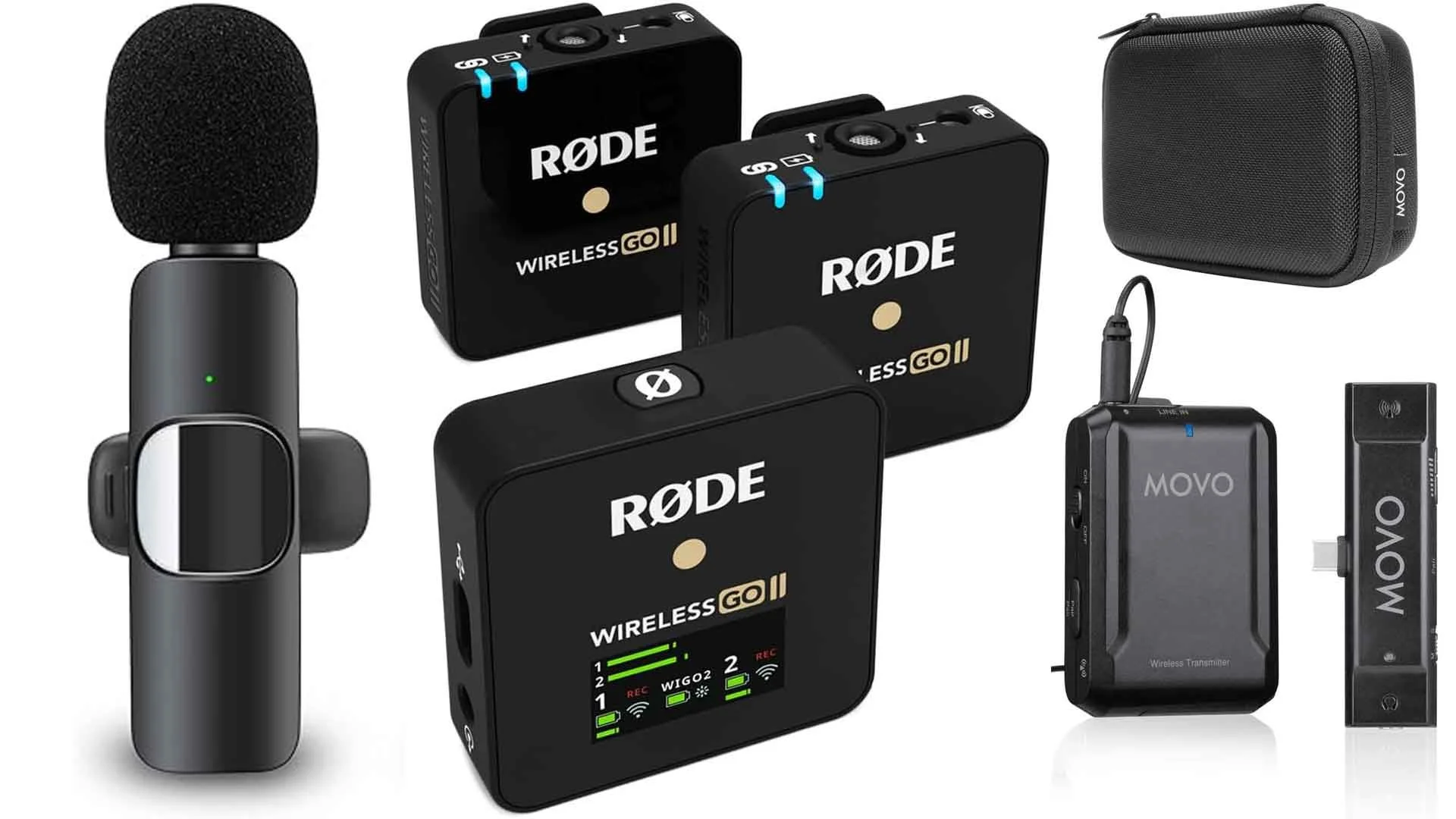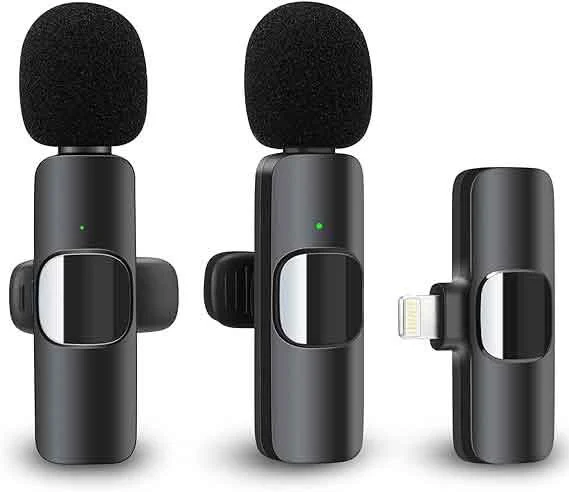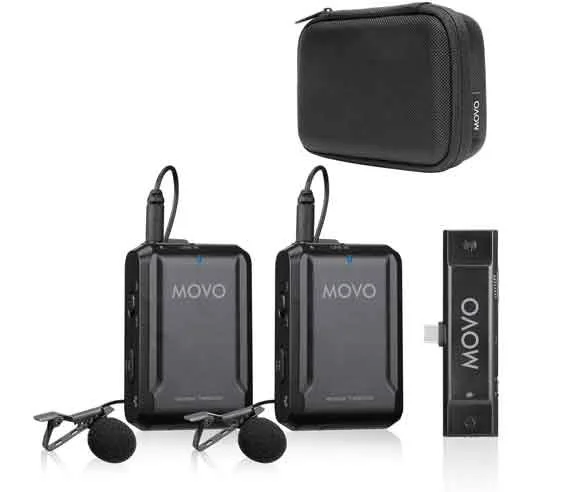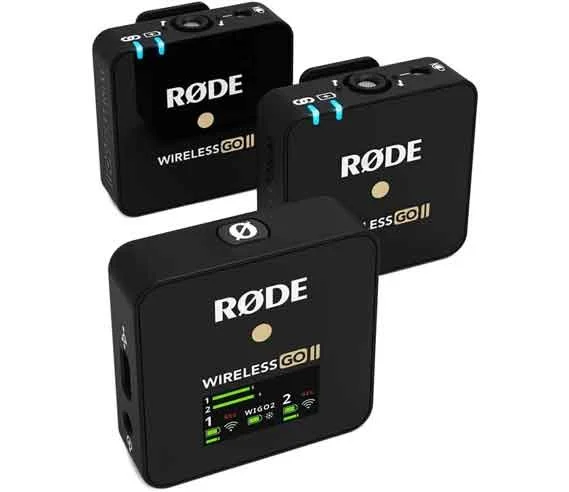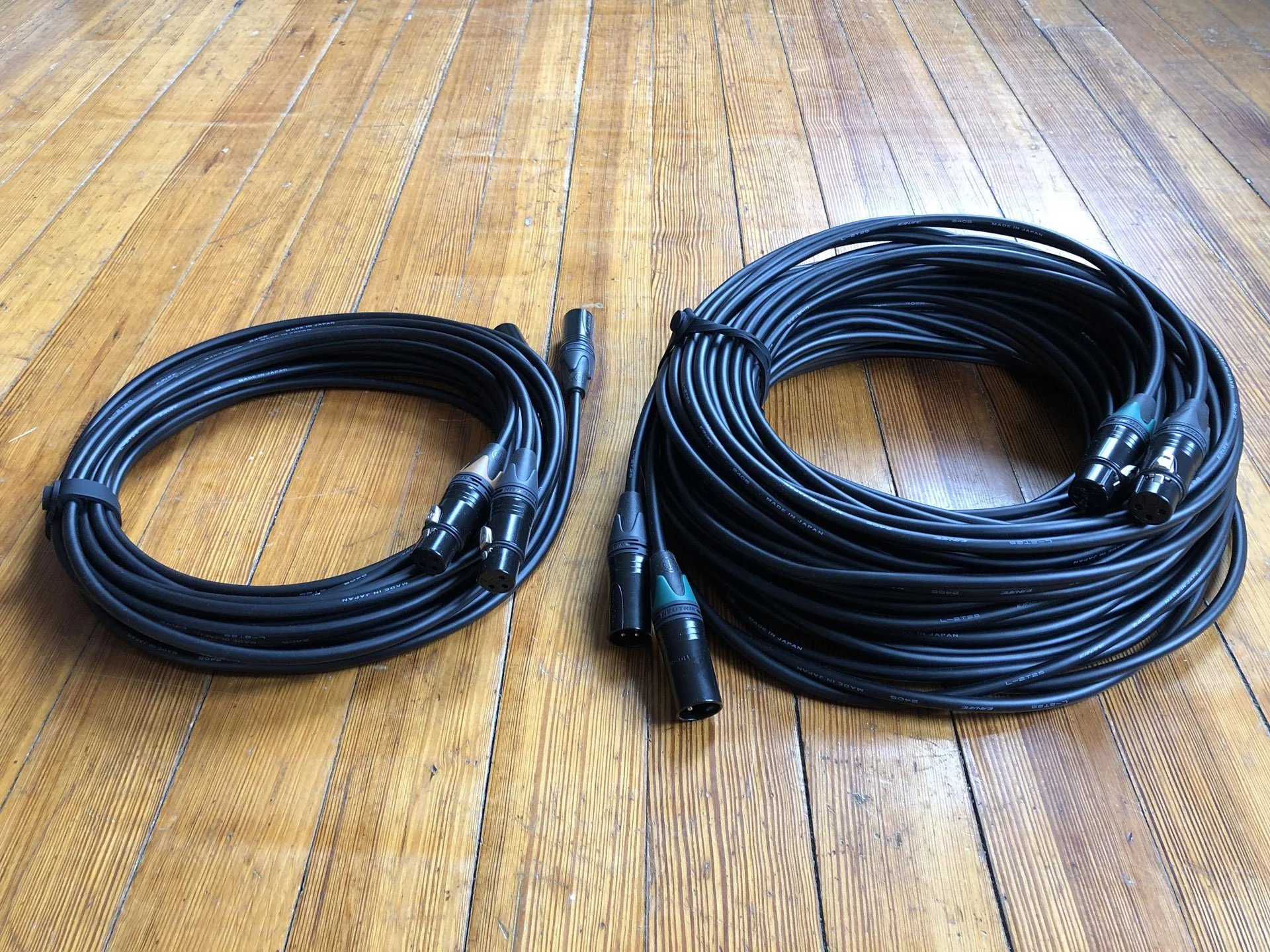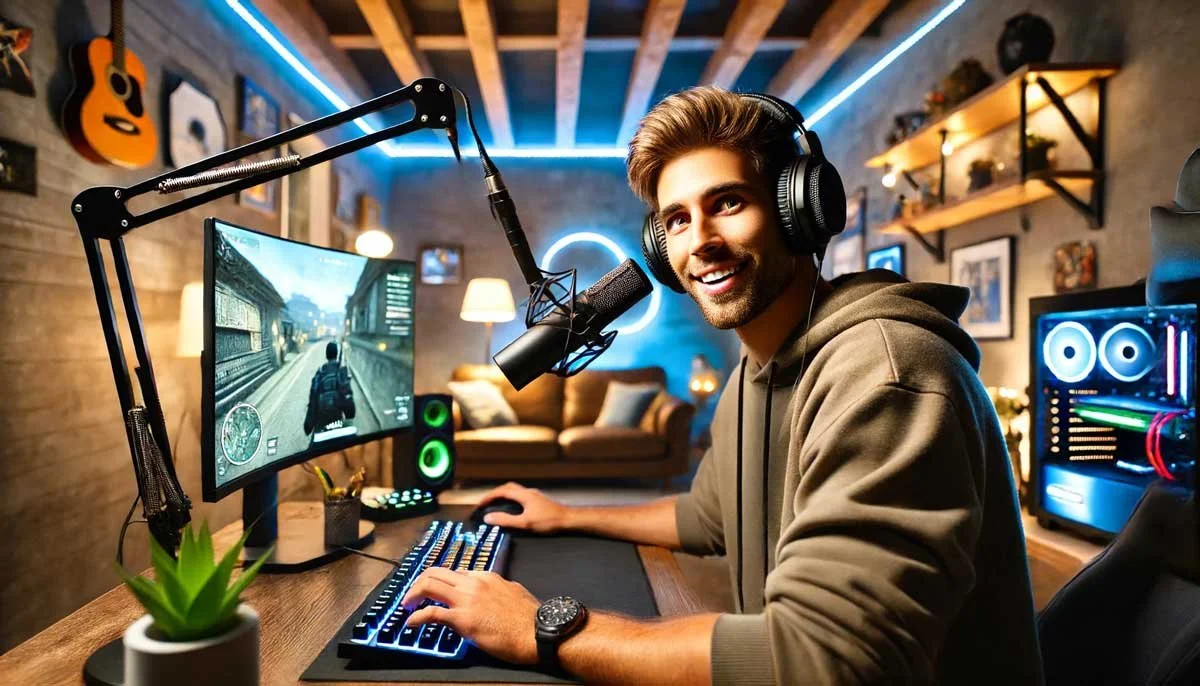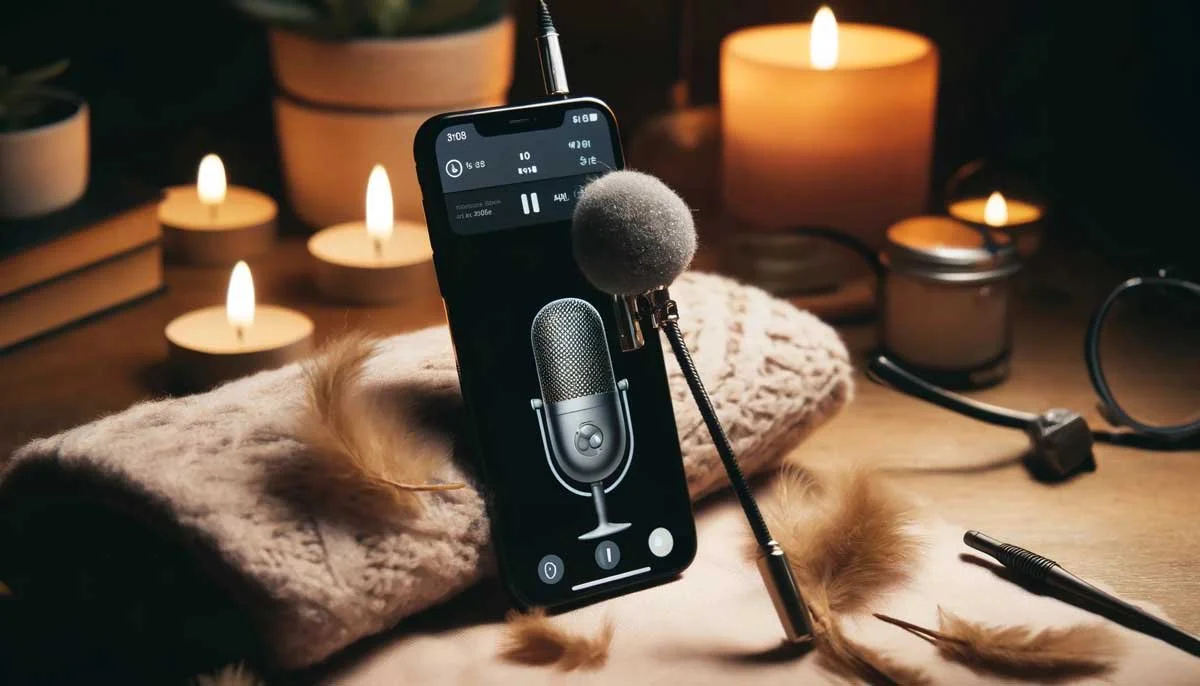Best Wireless Lavalier Microphone for iPhone
Enhancing Your iPhone Audio: A Guide to the Best Wireless Lavalier Microphones
TLDR: Best Wireless Lav Mics for iPhone
1. Beginners: HMKCH Wireless Lavalier
Features: The HMKCH Wireless Lavalier system offers plug-and-play simplicity for iPhones, a 65-foot range, and dual microphones with real-time auto-sync technology, making it effective for clear recordings in noisy environments.
Ideal User: This system is great for consumers and hobbyist recorders who need an easy-to-use, cost-effective solution for enhancing audio quality in personal projects, casual vlogs, or small-scale interviews.
2. Prothusiasts: Movo Edge Duo
Features: This system is budget-friendly and provides a 200-foot range, omnidirectional microphones, and simple AAA battery operation for the transmitters. It includes a hard case for portability and additional clips for flexibility.
Ideal User: Ideal for amateur videographers, educators, and content creators who need an affordable and reliable wireless system. It’s particularly well-suited for beginners and those involved in educational content, interviews, or light outdoor use.
3. Professionals: Rode Wireless Go II
Features: The Rode Wireless Go II excels with its dual microphone setup, internal recording capabilities, and extensive range of up to 656 feet. It supports both single and dual-channel configurations and offers built-in storage for uncompressed audio recording.
Ideal User: Perfect for professional videographers, podcasters, and journalists who require a versatile, high-quality audio solution for various recording environments, particularly in situations where mobility and range are critical.
Disclaimer: This blog post contains affiliate links. If you make a purchase through one of these links, I may receive a small commission at no additional cost to you. This helps support my work and allows me to continue providing valuable content. Thank you for your support!
Cheapest
HMKCH Wireless Lavaliers
For around $20, the HMKCH Wireless Lavalier System for iPhones, a user-friendly, dual-microphone setup designed for effortless mobile audio capture.
• Plug & Play Simplicity: No need for apps or Bluetooth, just connect the receiver to your iPhone and start recording instantly.
• Dual Microphone System: Comes with two omnidirectional lavalier microphones, allowing for multi-source recording—ideal for interviews or co-hosted podcasts.
• Intelligent Noise Reduction: Features professional-grade noise reduction technology to ensure clear audio capture, even in noisy environments.
Pros
- Affordable
- Simple Setup
- Small
- Includes 2 mics for interviews
Cons
- 4-6 hour battery life
- Only supports iOS 13-15.2
Good Value
Movo Edge Duo
Traditional lavalier microphone design with wireless bodypack transmitters.
• Extended Wireless Range: Capable of capturing clear audio up to 200 feet away, perfect for filming in diverse settings without losing signal quality.
• Omnidirectional Microphones: Comprehensive coverage with two omni lav mics.
• Battery-Powered Transmitters: Utilizes easily replaceable AAA batteries, offering continuous recording flexibility without the need for frequent recharging.
• Portable and Durable: Comes with a hard protective case for easy transport and storage, safeguarding your audio equipment during travel.
Pros
- 200 foot range
- AAA batteries
- Hard carrying case
- Lightweight
- Composite toe
Cons
- May need to carry spare AAA batteries
Best Overall
Rode Wireless Go II
The ultimate wireless lavalier microphone system for iPhone users, featuring dual mic recording, extensive range, and onboard storage.
• Advanced Audio Quality: Features omnidirectional microphones that capture a wide frequency range of 50Hz to 20kHz, providing crisp and clear audio suitable for professional applications.
• Extended Operational Range: Delivers a robust wireless connection up to 656 feet, ensuring reliable audio capture even at considerable distances.
• Plug-and-Play Convenience: Easily connects to iPhones and other devices without the need for complicated setups, supporting immediate use in any environment.
Pros
- 656 foot range
- Dual recording - phone + internal storage
- Long battery life
Cons
- True lavalier form-factor requires additional purchase of 3.5mm lav mic
- Only 3 gain settings
Reviews
HMKCH Wireless Lavaliers
In an ever-evolving market of mobile audio recording solutions, the HMKCH Wireless Lavalier Microphone System presents itself as a budget-friendly option for iPhone users. With its appealing price tag of around $20 to $25, this system promises convenience without the hassle of cords and complex setups. Let's dive into what makes this product tick and whether it stands up to practical use.
NOTE: If you have the iPhone 15 or newer, you’ll need the USB-C version here.
Packaging and Unboxing
Upon receiving the HMKCH Wireless Lavalier Microphone System, the first thing you'll notice is its straightforward, no-frills packaging.
The box includes two microphones, each with a lapel clip, a lightning receiver, and a USB-C cable for charging.
The inclusion of two microphones at this price point is awesome, offering great value for those needing multiple audio inputs, whether for interviews or mobile podcasting.
Design and Build
The design of the microphones is compact and unobtrusive, making them easy to clip on a shirt or collar without drawing too much attention.
Each microphone has a built-in rechargeable battery that delivers 4-6 hours of recording time, which should suffice for most recording sessions or podcasts.
Additionally, the plug-and-play functionality—requiring no apps or Bluetooth connectivity—simplifies the user experience significantly.
Performance
The HMKCH system boasts a 65-foot range, which is more than adequate for most recording environments, although the practical usability at this range can vary depending on obstacles and interference.
The microphones feature omnidirectional capsules that are decent at picking up sound from all directions, though they don't quite match the clarity and richness of more expensive professional-grade microphones.
One of the standout features is the dual microphone setup, which allows for simultaneous recording from two sources.
This is incredibly useful for interviews.
The system's real-time auto-sync technology is another highlight, reducing post-production work by ensuring that the audio syncs up with video effortlessly.
Audio Quality
In terms of audio quality, the HMKCH microphones perform well in controlled environments.
They feature intelligent noise reduction technology, which helps to filter out background noise, though it's not foolproof in highly noisy settings.
The sound captured is clear enough for casual use, vlogs, and basic interviews, but audio professionals might find it lacking in depth and fidelity compared to higher-end equipment.
Comparisons and Usability
When compared to traditional wired solutions, like an XLR microphone setup, the HMKCH falls short in terms of audio control and quality.
However, most wireless systems sacrifice some degree of quality.
For users who value mobility and simplicity over professional-grade sound, this microphone system hits the mark.
Final Thoughts
The HMKCH Wireless Lavalier Microphone System for iPhones is a commendable product for amateurs and hobbyists looking to improve their audio recording capabilities without breaking the bank.
Its ease of use, combined with the flexibility of having two wireless microphones, makes it a practical choice for podcasters, YouTubers, and mobile journalists on the go.
While it won't replace more sophisticated audio setups, for everyday use and non-professional applications, it offers a great balance of performance and affordability.
The additional perks, like the USB-C charging and the compact size of the microphones, sweeten the deal, making this system a smart investment for those who need decent quality audio without any fuss.
Movo Edge Duo
The Movo Edge Duo represents a significant step forward for iPhone videographers and audio enthusiasts looking for a reliable wireless lavalier mic system.
Tailored specifically for iOS devices, this system promises robust functionality packed into a convenient, travel-friendly package.
NOTE: If you have an iPhone 15 or newer, you’ll need to get the USB-C version here.
Design and Build
The Movo Edge Duo system is thoughtfully packaged, coming in a sturdy mobile case that not only makes it easy to carry but also protects the equipment during transit.
The kit includes two transmitters, each equipped with a jack for either a microphone or a line-in device, and a single receiver that connects directly to your iPhone via a lightning connector, facilitating a seamless integration with iOS devices.
Each transmitter operates on two AAA batteries, a design choice that circumvents the need for frequent recharging and can be a lifesaver during extended recording sessions where charging facilities may be unavailable.
This battery-powered approach ensures that users can continue recording with minimal interruption, simply by replacing the batteries as needed.
Audio Performance
The omnidirectional mics included in the Movo Edge Duo are designed to capture sound from all directions, making them exceptionally versatile for various recording scenarios, whether it's interviews, podcasts, or dynamic video content.
The system boasts a substantial wireless range of up to 200 feet, ensuring clear audio capture even at significant distances from the recording device.
This feature is particularly useful in scenarios where mobility and range are required, such as capturing dialogue across different rooms or outdoor spaces.
Setup and Usability
Setting up the Movo Edge Duo is straightforward. The pairing process involves a simple button press on the receiver while connected to your iPhone, followed by a similar action on the transmitter.
Once paired, a solid blue light indicator confirms the successful connection, allowing users to start recording immediately. This ease of setup is a boon for professionals and amateurs alike, reducing setup time and complexity.
Audio Quality Test
In practical tests, the audio captured by the Movo Edge Duo is impressively clear and robust.
Conclusion
The Movo Edge Duo wireless microphone system for iPhones is a well-thought-out solution that addresses the core needs of mobile recordists and videographers.
With its straightforward setup, robust audio quality, and the practicality of battery-powered operation, it stands out as a reliable choice for those who need dependable audio performance on the go.
Whether you are a professional videographer, a podcaster, or a journalist, the Movo Edge Duo offers the functionality and ease of use that can significantly enhance your audio recording capabilities.
Rode Wireless Go II
When it comes to capturing high-quality audio seamlessly on the move, the Rode Wireless Go II stands out as a premier choice for iPhone users seeking a robust wireless lavalier microphone system.
This system combines flexibility, performance, and convenience, making it ideal for podcasters, vloggers, and mobile journalists.
Let's explore what makes the Wireless Go II a standout product.
Design and Build Quality
Compact and discreet, the Rode Wireless Go II is engineered for on-the-go usage.
The system consists of two tiny transmitter mics and a receiver, each small enough to clip directly onto your clothing or slip into a pocket.
Despite their small size, these units are built to endure the rigors of fieldwork, with a solid construction that can handle being moved around in a variety of environments.
The transmitters are equipped with omnidirectional microphones that capture sound from all directions, ensuring that your audio is clear and consistent.
Performance Features
The Wireless Go II excels in its operational range and recording capabilities.
With a staggering range of over 600 feet, this system offers unprecedented freedom of movement.
It also allows for simultaneous recording from both transmitters, either to a camera, iPhone, or directly onto onboard storage, providing flexibility in how and where you use it.
Each transmitter can store up to seven hours of uncompressed audio, which is a significant advantage for extensive shooting sessions without immediate access to offload data.
User Interface and Functionality
Operating the Rode Wireless Go II is straightforward, though the fine-tuned gain controls and more detailed settings require access to a computer, which can be a minor inconvenience in the field.
The transmitters and the receiver display essential information such as battery life and signal strength, which is invaluable for monitoring your recording settings at a glance.
Additionally, the system uses a 2.4GHz digital transmission with 128-bit encryption, ensuring your audio is transmitted securely without interference, even in RF-dense environments.
Audio Quality
The audio quality provided by the Wireless Go II is crisp and professional, suitable for a wide range of recording needs from interviews to ambient sound collection.
The built-in microphones have a frequency range of 50Hz to 20kHz, offering a sound profile that captures voices naturally and clearly.
The omnidirectional pattern ensures that you get consistent audio levels regardless of the microphone's orientation.
Final Thoughts
The Rode Wireless Go II is an exemplary solution for iPhone users in search of a high-quality, versatile wireless lavalier microphone system.
Its robust feature set, combined with ease of use and exceptional performance, justifies its position as the best overall choice in the market.
Whether you're recording interviews, podcasts, or capturing ambient sounds, the Wireless Go II offers a reliable, professional audio recording experience that is hard to match.
Buyer’s Guide
Whether you're a professional videographer, a budding podcaster, or an avid vlogger, selecting the right wireless lavalier microphone system for your iPhone can significantly enhance the quality of your audio recordings. This guide will help you navigate through the various factors to consider, ensuring you find the perfect match for your recording needs.
Understanding Wireless Lavalier Systems
1. What is a Wireless Lavalier Mic? A wireless lavalier microphone, often called a lapel mic, is a small microphone that attaches to the speaker's clothing. It offers hands-free operation, making it ideal for interviews, presentations, or any situation where mobility is necessary.
2. Components of the System:
Transmitter: Worn by the user, it captures the audio and sends it wirelessly.
Receiver: Connects to the recording device (in this case, an iPhone) and receives the audio signal from the transmitter.
Microphone: The actual mic that clips to the user’s clothing.
-
For anyone using an iPhone to capture audio, whether for video production, podcasting, or live presentations, choosing the right wireless lavalier microphone system can make a significant difference in the quality and professionalism of the output.
Introduction to Wireless Lavalier Systems
A wireless lavalier microphone system typically consists of three key components: a microphone, a transmitter, and a receiver.
The microphone captures the audio and is usually clipped discreetly to clothing.
The transmitter, connected to the microphone, sends the audio wirelessly to the receiver, which is connected to the recording device—in this case, an iPhone.
Key Features to Consider
1. Connectivity:
Ensure the system is compatible with iOS devices. Some systems use a lightning connector, while others may require an adapter.
2. Audio Quality:
Look for systems with high-quality sound capture. Consider mics with omnidirectional patterns to capture clear sound from all directions.
3. Range:
Consider the transmission range. A longer range is beneficial if you need to record audio from a distance.
4. Battery Life:
Check the battery life of both the transmitter and receiver. Systems that use replaceable batteries can provide convenience in extended sessions.
-
When shopping for a wireless lavalier microphone system for your iPhone, there are several critical features to consider.
These features will determine the system’s suitability for your specific needs, whether you're recording podcasts, conducting interviews, or capturing audio for video productions.
Here’s what you should keep in mind:
1. Compatibility with iPhone
Connection Type: Ensure that the microphone system can connect to your iPhone. Since iPhones lack a headphone jack, look for systems that offer a Lightning connector or include an appropriate adapter.
iOS Compatibility: Some systems offer features that integrate seamlessly with iOS, such as apps that allow you to control the mic settings directly from your phone.
2. Audio Quality
Microphone Type: Lavalier mics typically use omnidirectional capsules that pick up sound from all around the microphone.
This is suitable for most purposes but consider a system with the option for directional mics if you need to focus on sound coming from one direction and minimize other noise.
Frequency Response: The range of sound frequencies the microphone can pick up.
A broader frequency response is generally better for capturing a full, natural sound.
Sample Rate and Bit Depth: These determine how accurately the sound is digitized.
Look for a system that supports a sample rate of at least 44.1kHz and a bit depth of 24 bits to ensure high-quality sound.
3. Transmission Technology and Range
Frequency Band: Common bands are UHF and 2.4 GHz. UHF is preferred for its reliability and range, though it can be more complex to set up. 2.4 GHz offers ease of use and is less prone to requiring user configuration.
Range: Evaluate how far the transmitter can be from the receiver without losing signal quality.
This is crucial if you need mobility and flexibility during recordings.
4. Battery Life and Power Options
Battery Duration: Longer battery life is essential for extended recording sessions.
Check how long the transmitter and receiver can operate on a full charge or a fresh set of batteries.
Rechargeable vs. Replaceable: Some systems use rechargeable batteries, while others use standard disposable batteries.
Consider which is more convenient and cost-effective for your use case.
5. Ease of Use
Setup Simplicity: Wireless systems should be easy to set up and pair with your device. Systems that are plug-and-play are ideal for quick setups.
Controls and Indicators: Useful features include clear battery life indicators, easy-to-access mute buttons, and adjustable gain controls directly on the transmitter or through an app.
6. Durability and Build Quality
Construction Quality: Look for systems that are robust enough to handle regular use, especially if you'll be using them in various locations or outdoor settings.
Weather and Shock Resistance: If you anticipate using the microphone outdoors, consider whether you need features like moisture resistance or rugged enclosures to protect against drops and other impacts.
7. Portability and Accessories
System Size and Weight: Consider the size and weight of the system, especially if you will be carrying it around frequently.
Included Accessories: Check what’s included in the box, such as carrying cases, extra clips, windshields for microphones, and additional cables which might be necessary for your recording setup.
8. Regulatory Compliance and Interference
Frequency Regulations: Make sure the system complies with local regulations on radio frequency use to avoid interference with other devices.
Interference Handling: Especially in environments with many competing signals, ensure the system has capabilities to manage interference effectively.
Additional Tips
1. Test the Range and Interference:
Before finalizing a purchase, test the microphone system in the environment where you will most often use it to ensure there is minimal interference and the range is adequate.
2. Consider the Accessories:
Some systems come with useful accessories like carrying cases, additional microphones, or extra clips. These can provide significant value.
3. Warranty and Support:
Opt for brands that offer good customer support and warranty terms, which can be invaluable in case of technical issues.
-
Selecting the right wireless lavalier microphone for your iPhone involves more than just comparing specs and prices.
Here are some additional tips to help you make an informed decision and get the most out of your purchase.
1. Test Before You Commit
Try Before Buying: If possible, test different microphones to see how they perform with your specific iPhone model.
This can help you assess audio quality, connectivity, and ease of use in a real-world setting.
Renting Options: Consider renting a few models to test them during actual recording sessions.
This can be a cost-effective way to determine which system best meets your needs before making a purchase.
2. Check for Upgradability and Compatibility
Future-Proofing: Look for systems that offer firmware updates to enhance functionality or fix bugs.
This can extend the lifespan of the product and improve performance over time.
Compatibility with Other Devices: While your current need might be for iPhone compatibility, consider whether the system can also be used with other devices, such as cameras or computers, to maximize its utility.
3. Evaluate the Total Cost of Ownership
Initial Cost vs. Long-Term Value: In addition to the purchase price, consider the cost of accessories, replacement batteries, and potential repair fees.
A cheaper system might end up being more expensive in the long run if it requires frequent accessory replacements or isn’t as durable.
Warranty and Support: Check the warranty length and what it covers. Systems with a comprehensive warranty can offer peace of mind and protect against defects.
Also, consider the manufacturer’s customer support reputation.
4. Understand the Use Case
Recording Environment: Consider the typical environments in which you will use the mic.
If you record in noisy or outdoor settings, look for mics with features that help minimize background noise or are specifically designed for outdoor use.
Type of Content: The best mic for you may depend on the type of content you produce. For instance, interviews might require different features compared to live performances or presentations.
5. Seek User Feedback and Reviews
User Reviews: Online reviews and forums can be a great resource to learn about the real-world performance of different lavalier mic systems.
Pay attention to reviews from users who are using the microphones in similar contexts to your own.
Professional Feedback: If possible, seek feedback from professionals in the audio recording industry.
Their insights can help you understand which features are most important for your specific applications.
6. Plan for Mobility and Storage
Mobility Needs: If you move around a lot while recording, look for a system that is lightweight and has a secure clip to keep the mic in place.
Also, wireless range is a critical factor if you need to move freely without disrupting the audio connection.
Storage Solutions: Consider how you will store and transport the microphone system.
Protective cases can keep your equipment safe and organized, which is especially important for delicate electronics.
7. Anticipate Additional Accessories
Essential Extras: Some systems may not include all necessary accessories.
You might need to purchase additional items like windshields (deadcats), extended cables, or carrying pouches.
Customizable Options: Some microphone systems allow for the use of interchangeable capsules or accessories that can enhance performance for specific applications, such as reducing wind noise or allowing for stereo recording.
Comparison of Our Top-3 Picks
When choosing a wireless lavalier microphone system for an iPhone, users have a variety of options, each with its distinct features and ideal use cases.
Here's a detailed compare and contrast of the Rode Wireless Go II, Movo Edge Duo, and HMKCH Wireless Lavalier systems to help identify the best fit for different recording needs.
Audio Quality and Performance
The Rode Wireless Go II is renowned for its superior audio quality, making it a favorite among professionals. It captures sound with remarkable clarity and minimal interference, thanks to its advanced transmission technology. This system also allows for internal recording, providing a safety net in case of connection issues.
In contrast, the Movo Edge Duo and HMKCH Wireless Lavalier are more suited for non-professional environments.
The Movo Edge Duo offers decent audio quality suitable for amateur videography and content creation, with omnidirectional microphones that capture sound from all around, ensuring a natural sound capture.
Meanwhile, the HMKCH system, while providing clear audio, might not reach the depth and fidelity of the Rode due to its simpler design and lower cost components, but it excels in simplicity and ease of use for casual recorders.
Range and Connectivity
Range and connectivity are crucial for users who need to move around freely while recording.
The Rode Wireless Go II boasts an impressive range of up to 656 feet, making it ideal for filming in large spaces or outdoors.
The Movo Edge Duo also performs adequately with a 200-foot range, which is sufficient for classroom settings, small studios, or indoor events.
The HMKCH Wireless Lavalier, however, has a more limited range of 65 feet, which is best suited for close-range applications like personal vlogs or simple interviews where the user does not stray far from the camera.
Ease of Use and Battery Life
For ease of use, the HMKCH Wireless Lavalier shines with its plug-and-play functionality that's particularly appealing to those new to audio equipment. It doesn't require any complex setup, making it accessible for everyday users.
The Movo Edge Duo is also user-friendly but requires handling AAA batteries, which can be a pro or con depending on user preference for rechargeable versus disposable batteries.
The Rode Wireless Go II, while being the most professional system of the three, is relatively straightforward to operate but does require a bit more initial setup to take full advantage of its features.
Battery life is another important consideration.
Both the Rode Wireless Go II and Movo Edge Duo offer long battery life (up to 7 hours for Rode and long hours for Movo depending on the batteries used).
In contrast, the battery life for the HMKCH system is slightly less, ranging between 4-6 hours.
Overall Suitability
Each of these systems targets slightly different users.
The Rode Wireless Go II is ideal for professional videographers and broadcasters who need reliable, high-quality audio capture across various environments.
The Movo Edge Duo suits educators, amateur videographers, and content creators who need a reliable system that balances cost and performance efficiently.
Lastly, the HMKCH Wireless Lavalier is perfect for casual users, hobbyists, or anyone looking for a straightforward, easy-to-use system for enhancing audio quality in personal projects or social media content without a significant investment.
Choosing the right system depends on balancing these factors against your specific needs, budget, and the types of projects you undertake.
Share this post to help the website grow.

